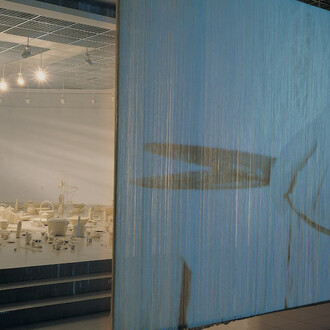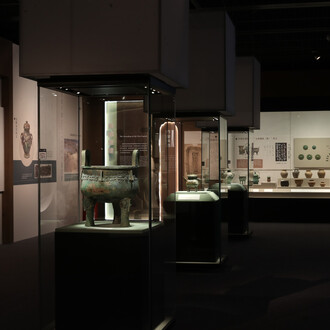Life is architecture and architecture is the mirror of life.
(I. M. Pei)
I. M. Pei: Life is architecture in Shanghai is co-organised by the Power Station of Art (PSA) and M+. The exhibition was initiated by M+ and first held in Hong Kong from June 2024 to January 2025. It is the first full-scale retrospective of Chinese American architect Ieoh Ming Pei (I. M. Pei, 1917–2019) in Chinese mainland and will be held from April 26 to July 27, 2025. Curated by Shirley Surya, Curator, Design and Architecture, M+, Hong Kong and Aric Chen, General and Artistic Director, Nieuwe Instituut (New Institute), Rotterdam and incoming Director, Zaha Hadid Foundation, London, this critically acclaimed exhibition was held in Hong Kong with the support of the Estate of I. M. Pei and Pei Cobb Freed & Partners, the architectural firm Pei cofounded. The exhibition in Shanghai is presented with the special support of Christian Louboutin.
Legendary architect I. M. Pei is widely known in China and is the most internationally influential Chinese American architect of the 20th century. He was awarded the Pritzker Prize, the world’s most prestigious architectural award, in 1983. Pei’s high-profile projects were realised over seven decades with an exceptionally wide geographic reach, including the National Gallery of Art East Building in Washington, D.C., the modernisation of the Grand Louvre in Paris, Fragrant Hill Hotel in Beijing, the Bank of China Tower in Hong Kong, Suzhou Museum, and the Museum of Islamic Art in Doha. These landmark projects solidified his legacy and position in global architectural history and popular culture.
Presenting the exhibition “I. M. Pei: Life Is Architecture” in Shanghai revisits the place where Pei’s lifelong architectural journey began—where he studied and grew up. Arriving in Shanghai from Hong Kong with his family in 1927 at the age of 10, Pei attended the Shanghai Middle School of the YMCA in China and St. John’s Middle School, the secondary school of Saint John’s University in Shanghai. During that time, Pei frequently traveled between Suzhou and Shanghai, traversing the historical and culturally-specific built environment of Jiangnan gardens and the modern landscape of a cosmopolitan city. These early multicultural spatial experiences inspired him to focus on exploring and interpreting locality and historical archetypes within a transcultural and modern milieu.
The exhibition I. M. Pei: Life is architecture at PSA, Shanghai will feature more than 400 objects, including original drawings, architectural models, photographs, films, and other archival documentation from institutional and private holdings, many of them never exhibited in Chinese mainland before. The exhibition takes a close look at Pei’s life and work through six areas of focus that not only define his unique practice, but also place his architectural projects in dialogue with social, cultural, and biographical trajectories, showing architecture and life to be inseparable.
"Pei’s Cross-Cultural Foundations" shows how Pei’s upbringing and architectural education formed the foundation of his ability to reconcile multiple sources of influence across cultures and between tradition and modernity.
"Real Estate and Urban Redevelopment" unveils a lesser-known phase of Pei’s career as part of real estate developer Webb & Knapp in New York City. It explores his contributions to mixed-use planning, housing, and urban revitalisation projects in the United States in the 1960s, and subsequently beyond American borders.
“Art and Civic Form” introduces Pei’s museum designs and his frequent collaborations with artists from Henry Moore to Zao Wou-Ki. The section demonstrates his belief in museums as civic spaces, the importance of dialogue between art and architecture, and his deep affinity with the contemporary art of his time.
"Power, Politics, and Patronage" reveals how Pei—with his technical mastery, ingenious problem-solving, and sensitivity to client needs—became a trusted collaborator in high-profile commissions that drew both immense support and public controversy throughout his career.
“Material and Structural Innovation” illustrates Pei and his team’s consistent inventiveness in the use of materials and construction methods, especially with concrete, stone, glass, and steel.
“Reinterpreting History through Design” examines Pei’s long-standing interest in making modern architecture relevant to different histories, traditions, and ways of life, particularly those related to his birthplace of China. Pei distilled the essence of cultural and historical archetypes to provide formal or spatial strategies for contemporary needs.
The exhibition is designed by architect James Wei Ke, who seeks to highlight what he interprets as the most representative spatial and formal elements in Pei’s architectural design and approach. With an emphasis on the re-composition of these elements into a polyphonic structure within PSA’s venue, the installation unfolds with various focal points, dynamic rhythms, and flexible arrangements, offering viewers a multi-perspective experience reminiscent of a Chinese garden.
Suhanya Raffel, Museum Director, M+, says, “M+’s critically acclaimed exhibition I. M. Pei: Life is architecture is the second Special Exhibition curated by the museum to embark on a world tour after the enormous success of Yayoi Kusama: 1945 to now to Spain and Portugal in 2023 and 2024 respectively. Seven years in the making, the exhibition distils extensive research and profound insights, exemplifying M+’s exceptional curatorial expertise and vision. We are delighted to partner with Power Station of Art to bring this retrospective to a broader audience, particularly in light of Pei’s formative years and architectural projects in China. This exhibition reintroduces Pei and his significant contributions while illuminating often-overlooked facets of his remarkable career.”
Gong Yan, Director of PSA, says, “Pei’s architecture emerges from his mobility across diverse cultures. Rather than being overwhelmed by nostalgia, dislocation and alienation have shaped his unique philosophy of life and his distinctive approach to meet the diverse needs of his clients. Humility, pragmatism, wisdom, and generosity define both his life spirit and the cultural essence of his architecture.
A series of inspiring and intriguing lectures and discussions will be presented throughout the exhibition period. The roundtable discussion Rethinking legacy, biases, practice: I. M. Pei and China, moderated by Shirley Surya, co-curator of the exhibition and curator of design and architecture at M+, will be presented on the day of the exhibition opening, and six guests - Ding Wowo, Huang Wenjing, Liu Kecheng, Liu Yichun, Lin Bing, James Wei Ke - will share their insights on Pei’s specific architectural works and methodology, drawing from their respective experiences as architects, educators, and critics. As the first collaborative project following the signing of the Memorandum of Understanding between PSA and M+, this exhibition has also been enlisted as a key project of WestK Shanghai Week 2025. Also as part of the WestK Shanghai Week 2025, M+ and PSA will co-organise a public talk on 19 June, featuring architect Li Chung (Sandi) Pei, I. M. Pei’s son, partner and founder of PEI Architects, and artist Xu Bing. Moderated by Shirley Surya, the discussion will delve into I. M. Pei’s interest in the art of his time, his engagement with certain artistic practices, and his collaborations with artists in the design of his buildings.
















